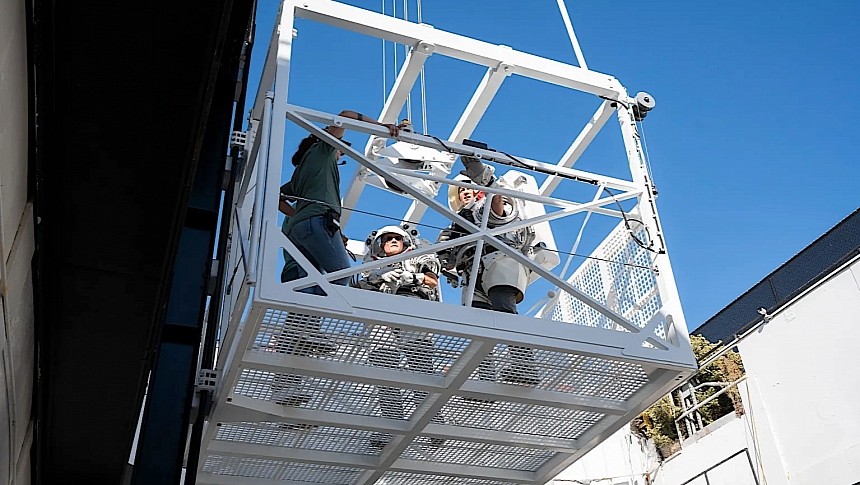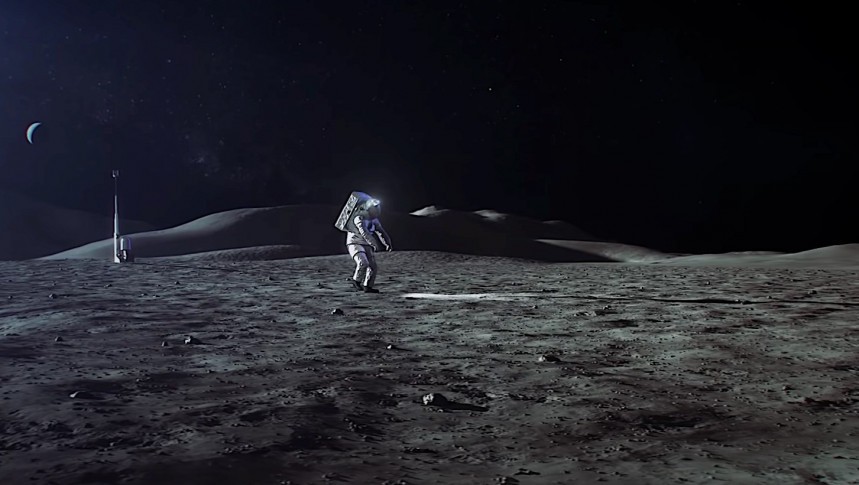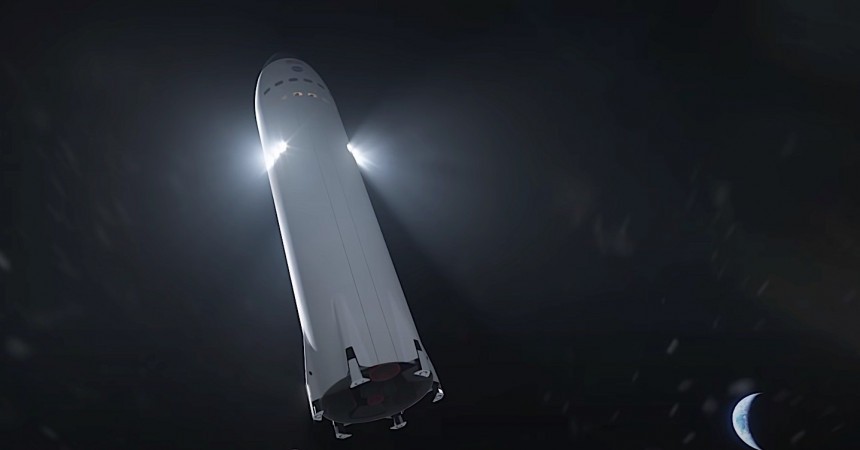Come 2025, and assuming everything goes according to plan on Artemis mission number two, humans will finally make a comeback to the Moon. That's more than two years from now from our perspective, but from that of rocket scientists, just around the corner.
What that means is that NASA and all the parties involved are hard at work trying to put all the pieces of the mission together. And for the most part, especially when it comes to the Space Launch System (SLS) rocket and the Orion capsule, we get almost constant updates of developments.
Not the same can be said about a component of the mission, one of the most important, called the SpaceX Starship human landing system (HLS). That's the bit of hardware that will take two astronauts from the Orion to the surface of the Moon, ensure their survival there for up to a week, and then carry them back to the spaceship for the return trip home.
NASA selected the Musk-owned company to make the lander back in 2021, and since then we've had zero updates on the progress made with it. So imagine our surprise when we stumbled on a piece of fresh news regarding the HLS this week.
The update does not concern the lander per se, but one of its components, namely the elevator that will move cargo and crew from inside the lander's habitable area to the surface of the Moon.
We're hearing about it not thanks to SpaceX but on account of NASA sending two of its people over to the space company's facility in Hawthorne, California, to have a look at what's going on there.
The two people are astronauts Nicole Mann, commander of the SpaceX Crew-5 mission sent to the International Space Station (ISS) in October last year, and Doug Wheelock, a veteran of the ISS.
The duo was introduced to and had a feel of a sub-scale mockup version of the Starship elevator, a contraption that in the photos NASA released looks seriously underwhelming, not unlike the elevators miners use to go down into the Earth's crust.
The two toyed around with the elevator in its flight-like design, meaning that's probably how the real thing will look as well. Aside from allowing NASA people to have their say on the design, the visit to SpaceX also serves, as per NASA, as a functional demonstration of the hardware.
The model they tested comes with a full-scale basket section and features, for testing purposes, functioning mechanical assemblies and crew interfaces. To properly get a feel of the thing, both Mann and Wheelock were fully suited in garments meant to simulate the size and mobility of the Axiom Space-developed spacesuits that would actually be worn during the Artemis III and IV missions.
We are not told if the astronauts were happy with what they experienced or not, but we do know what they were up to while in Cali. We're told the astronauts were able to provide feedback on elevator controls, including the latches, the interfaces that allow the deployment of the ramps that allow access on and off, and the amount of available space for whatever cargo will have to be transported to the surface of the Moon.
Separately, dynamic operations were simulated with the elevator basket moving on a vertical rail system.
Technically speaking, SpaceX should have the entire Starship human landing system, elevator included, ready for a test run as soon as 2024. Because of the complete informational blackout, we have no idea whether the company will be able to meet the deadline or not.
When (and if) fully ready, the HLS will be a sort of precursory mission to Artemis III, as it will not leave our planet at the same time as the SLS and Orion. Instead, the private space company will send the lander to the Moon beforehand.
First, SpaceX will launch into Earth orbit a storage depot comprising fuel tanks. Once placed up there, the Starship will leave our planet as well, heading for the tanks waiting for it in space.
It will rendezvous with them and fill its tanks, setting a course for the Moon, where it will park in a set orbit around it, waiting for the humans of the Artemis III mission to arrive.
This is an approach that was never used before when humans are involved, thus is a high-risk one. Yet NASA and all the other parties involved in the daring project seem confident it will work and, despite the extra gear and procedures involved (when compared to the Apollo program from decades ago, at least), will safely put humans on surface of Luna, and officially kickstart what may very well be humanity's true expansion on the solar system.
And then you think about how the success of it all depends on a thing as trivial as a surprisingly low-tech elevator...
Not the same can be said about a component of the mission, one of the most important, called the SpaceX Starship human landing system (HLS). That's the bit of hardware that will take two astronauts from the Orion to the surface of the Moon, ensure their survival there for up to a week, and then carry them back to the spaceship for the return trip home.
NASA selected the Musk-owned company to make the lander back in 2021, and since then we've had zero updates on the progress made with it. So imagine our surprise when we stumbled on a piece of fresh news regarding the HLS this week.
The update does not concern the lander per se, but one of its components, namely the elevator that will move cargo and crew from inside the lander's habitable area to the surface of the Moon.
We're hearing about it not thanks to SpaceX but on account of NASA sending two of its people over to the space company's facility in Hawthorne, California, to have a look at what's going on there.
The two people are astronauts Nicole Mann, commander of the SpaceX Crew-5 mission sent to the International Space Station (ISS) in October last year, and Doug Wheelock, a veteran of the ISS.
The two toyed around with the elevator in its flight-like design, meaning that's probably how the real thing will look as well. Aside from allowing NASA people to have their say on the design, the visit to SpaceX also serves, as per NASA, as a functional demonstration of the hardware.
The model they tested comes with a full-scale basket section and features, for testing purposes, functioning mechanical assemblies and crew interfaces. To properly get a feel of the thing, both Mann and Wheelock were fully suited in garments meant to simulate the size and mobility of the Axiom Space-developed spacesuits that would actually be worn during the Artemis III and IV missions.
We are not told if the astronauts were happy with what they experienced or not, but we do know what they were up to while in Cali. We're told the astronauts were able to provide feedback on elevator controls, including the latches, the interfaces that allow the deployment of the ramps that allow access on and off, and the amount of available space for whatever cargo will have to be transported to the surface of the Moon.
Separately, dynamic operations were simulated with the elevator basket moving on a vertical rail system.
Technically speaking, SpaceX should have the entire Starship human landing system, elevator included, ready for a test run as soon as 2024. Because of the complete informational blackout, we have no idea whether the company will be able to meet the deadline or not.
First, SpaceX will launch into Earth orbit a storage depot comprising fuel tanks. Once placed up there, the Starship will leave our planet as well, heading for the tanks waiting for it in space.
It will rendezvous with them and fill its tanks, setting a course for the Moon, where it will park in a set orbit around it, waiting for the humans of the Artemis III mission to arrive.
This is an approach that was never used before when humans are involved, thus is a high-risk one. Yet NASA and all the other parties involved in the daring project seem confident it will work and, despite the extra gear and procedures involved (when compared to the Apollo program from decades ago, at least), will safely put humans on surface of Luna, and officially kickstart what may very well be humanity's true expansion on the solar system.
And then you think about how the success of it all depends on a thing as trivial as a surprisingly low-tech elevator...
















